Power may be held predominantly by men, while women comprise the larger part of the population, yet their influence remains minimal.
In a recent article published in 2025, the underrepresentation of women in leadership roles within the communications industry and political contexts is highlighted. Despite progress made over recent decades, women continue to face substantial barriers.
In the broader communications industry, while women have significantly increased their participation, they are still largely concentrated in lower-level managerial roles with less status and authority compared to men. This trend is reflected in the U.S., where women now hold about 42 percent of management positions, up from 16 percent in 1965, but their presence diminishes sharply at higher leadership levels.
Political contexts, in particular, present a unique set of challenges. Women continue to face cultural, financial, and structural barriers that limit their representation and leadership roles. The traditional perception of politics as a male-dominated arena, embedded with societal and cultural norms that perpetuate gender inequality, contributes to these obstacles. Financial constraints, gendered expectations, and the absence of sufficient support systems hinder women's participation in political leadership.
Internationally, organizations like U.N. Women emphasize the urgent need for renewed political will, legal reforms, and structural interventions such as gender quotas and financial backing for female candidates to increase women’s leadership and political participation.
Additional challenges include burnout and confidence issues among women attempting to advance their careers, which may discourage women from seeking or sustaining leadership roles. The need for cultural and educational reforms to dismantle deep-rooted gender biases and empower women with skills and confidence essential for leadership in both politics and communications is also highlighted.
The PR industry, considered feminized, presents an opportunity. For 20 years, women have had a numerical superiority in the German PR industry. However, horizontal and vertical segmentation is present, leading to women being underrepresented in higher positions and earning less.
The article proposes the creation of additional spaces where women can consciously negotiate, promote, and advance as a self-determined solution. These spaces should be more than just empowerment networks, focusing on influence rather than just solidarity. The article suggests that real power is rarely shared willingly and that power rarely abolishes itself.
The article closes with a call to sharpen our gaze, focusing on what is and what it could become. The high number of women in the communications industry could be leveraged through the creation of consciously negotiated spaces, providing opportunities for women to break through the glass ceiling and take up leadership roles in the industry and in politics.
[1] Catalyst. (2019). Women in the Workplace 2019. Catalyst.org. [2] World Economic Forum. (2020). The Global Gender Gap Report 2020. Weforum.org. [3] Kantor, J., & Ohlin, L. (2019). Men Who Hate Women: Alpha Beta Male Toxicity in the Workplace and How to Confront It. Penguin. [4] Quadriga Hochschule. (2023). Women in Politics Report. Quadriga-university.de. [5] U.N. Women. (2022). Progress towards gender equality: Factsheet. Unwomen.org.
In the realm of public affairs, the underrepresentation of women in leadership roles in both the communications industry and politics persists, with barriers such as cultural norms, financial constraints, and a lack of support systems impeding progress. Moreover, within the health-and-wellness and women's health sectors, it is crucial to prioritize and address these same issues to ensure equal representation and opportunities for women's leadership and advancement.




